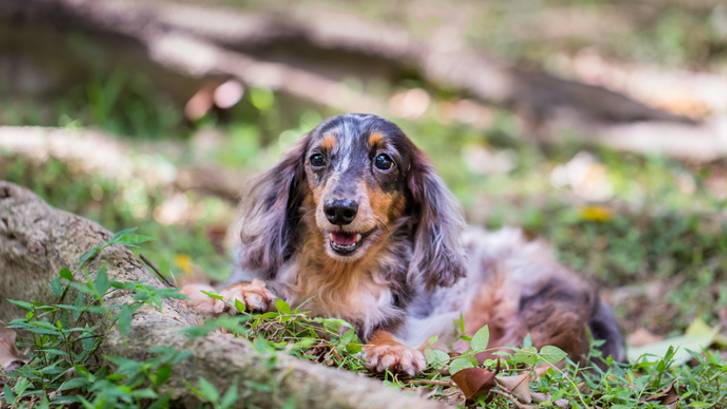Can dogs be autistic? A vet explains all
We know it can occur in humans — but can dogs be autistic? A vet explains everything there is to know

Can dogs be autistic? This is a question that’s become more and more common amongst pet parents in recent years, given the ever-increasing focus on identifying, diagnosing, and treating autism spectrum disorder (ASD) in the human world. So, it’s no wonder why some dog owners might be wondering if dogs can be autistic.
In humans, signs of ASD include difficulty understanding or communicating with others, repetitive or obsessive behaviors, sensory processing issues, anxiety, or shutdowns. But at present, ASD is only a recognized condition in humans. This is because research is lacking on ‘typical’ vs ‘atypical’ dog behaviors to make the same diagnosis in the canine world. However, dogs can present with many of the same symptoms as humans with ASD. This is why the term canine dysfunctional behavior (CDB) has been introduced into veterinary medicine.
For dogs with persisting behavior problems, it is understandable that owners might consider that their pup has additional needs. For example, do you have a dog who ignores you or avoids interactions with other canines? Or do they perform repetitive or compulsive behaviors, like tail chasing, circling, or excessive licking? These are some common symptoms of CDB. But here’s the good news: CBD can be managed. Whether it’s through a consistent routine, regular exercise, or by using the longest lasting dog chews to keep them busy and help minimize stress and anxiety.
It can be worrying to think your dog is living with an undiagnosed disorder. But don’t panic. Here, in her own words, vet, Dr. Diana Hasler, answers can dogs be autistic, what is canine dysfunctional behavior, and the symptoms to look out for. She’ll also explain when to visit your vet and other behaviors to look out for. Keep in mind: dogs with CDB can go on to live long, happy lives—they may just need a little extra support. So keep scrolling to find out everything there is to know.
What is autism?
Autism is a developmental disability in which individuals interact with the world differently than what is considered “typical”. Since 2013, the American Psychiatric Association has preferred the term “Autism spectrum disorder”, or ASD, to cover autistic disorder, pervasive developmental disorder, and Asperger syndrome. People with ASD are usually diagnosed as young children, and the exact cause is unknown.
As the name implies, the severity of ASD can vary from person to person. Some affected people can function with little support, while others may require a permanent carer. Signs of ASD include difficulty understanding or communicating with others, repetitive or obsessive behaviors, sensory processing issues, anxiety, and meltdowns or shutdowns.
Can dogs have autism spectrum disorder or other special needs?
Autism spectrum disorder is only a recognized condition in humans—there has not been enough research on typical vs atypical dog behaviors to make the same diagnosis in dogs. However, dogs can present with many of the same symptoms as people with ASD, so the term “canine dysfunctional behavior” (CDB) has been adopted in veterinary medicine.
In addition to CDB, some dogs exhibit similar behaviors to those seen in attention-deficit/hyperactivity disorder (ADHD), obsessive-compulsive disorder (OCD), and anxiety disorders in humans. These conditions may have overlapping features with CDB, which we will discuss later.
What is canine dysfunctional behavior?
Since ASD is a condition recognized in human medicine, dogs with similar symptoms may be diagnosed with CDB. It is believed that dogs with CDB are deficient in mirror neurons, which are thought to help dogs and puppies “mirror” other dogs’ behaviors when socializing. Interestingly, the mirror neuron system is theorized to be involved in human ASD as reported by Science Daily.
A scientific study was conducted by AVMA Journals on tail-chasing Bull Terriers to investigate the underlying cause. It found that tail chasing, a repetitive action, was associated with trance-like behavior and episodic aggression—behaviors also observed in ASD. It also showed that tail chasing was more common among male dogs, not unlike the higher rate of ASD diagnosis in boys and men.
Additionally, a follow-up study identified that both tail-chasing Bull Terriers and autistic children had elevated levels of neurotensin and corticotropin-releasing hormone, further emphasising the similarity between ASD and CDB.
Symptoms of canine dysfunctional behavior
Symptoms of CDB include:
- Antisocial behavior, such as ignoring their owner and avoiding interactions with other dogs
- Difficulty communicating, including avoiding eye contact and expressing themselves differently than other dogs
- Repetitive/compulsive behaviors, like circling, tail chasing, or obsessive chewing
- Hypersensitivity to stimuli, like petting or sudden noises
- Anxiety or aggression, often associated with specific triggers
Conditions that look similar to canine dysfunctional behavior

There are several conditions that can appear quite similar to canine dysfunctional behavior and it's worth being aware of them so that you can spot the differences. Let's take a look:
1. Hyperkinesis or canine hyperactivity/impulsivity and inattention
This condition is similar to ADHD in humans, with symptoms like hyperactivity, training aversion, and distress when overstimulated. A study by Translational Psychiatry saw that in more than 11,000 dogs found that hyperactivity, impulsivity, and inattention were most common in young male dogs, like the young male predisposition for ADHD.
2. Canine compulsive disorder
Canine compulsive disorder is similar to OCD in humans, but it has a different name since dogs cannot articulate their thoughts to allow us to determine whether they are obsessive. This condition is characterized by repetitive activities that serve no purpose such as tail chasing and flank sucking.
3. Canine anxiety disorders
Like humans, dogs can also experience anxiety. Anxiety is considered disordered when it persists over time, past the removal of the initial trigger. Dogs with anxiety disorders may tremble, vocalise, hide, pant when it isn’t hot, eliminate inappropriately, or display body language with their ears back, tail tucked, and teeth showing.
4. Intracranial neurological disorders
Diseases affecting the brain like tumors and encephalitis (inflammation/infection of the brain) can cause similar symptoms to CDB, including repetitive movements, hypersensitivity to stimuli, anxiety, and aggression.
How is canine dysfunctional behavior diagnosed?
Because of the lack of research on the subject, it is difficult to diagnose CDB in dogs. Unlike ASD, CDB does not have a spectrum, so vets rely on comparing abnormal behaviours with those considered normal.
If you suspect that your dog has CDB, your veterinarian will perform a full physical examination and relevant diagnostic tests to rule out any underlying causes of your dog’s symptoms. If these tests come back normal, your vet may refer you to a veterinary behaviourist specialising in canine behavioural disorders, which may or may not be covered by pet insurance.
How to manage canine dysfunctional behavior
Since it is primarily a behavioral disorder, CDB does not have a simple treatment or cure. However, identifying triggers can be helpful so that you can avoid situations that set off your dog. It is important to recognize that some aspects of CDB may not improve, such as social interaction skills, and these dogs’ wishes should be acknowledged to avoid causing distress.
Dogs with CDB benefit from a consistent routine with regular exercise to minimize stress and anxiety. They may require behavior modification training to cope with triggering stimuli, and in some cases, they may benefit from medications to address anxiety and compulsive behaviors.
When to visit your vet
If your canine companion has shown signs such as poor social skills, compulsive actions, oversensitivity to touch or sound, anxiety, or aggression, you should consult your veterinarian to investigate the possibility of CDB. Like many people with ASD, dogs with CDB can go on to live long, happy lives—they may just need more support along the way.
If you found this feature helpful, check out What to do if you encounter aggressive dog behavior.
After graduating with a distinction as a veterinarian from The University of Edinburgh in 2018, Dr Diana Hasler went on to become a full-time veterinary surgeon treating many dogs, cats, rabbits, and rodents. Diana is passionate about the animal world and has written for various online and print publications like Pet News Daily. She is also a regular and loyal contributor to Pets Radar, using her specialist knowledge and access to the latest research to write informative first-person pieces. She also works in the world of medical communications, editing medical documents, original research articles, case studies, and review papers to prepare them for scientific journal submission. Currently, Dr. Hasler lives in Edinburgh where she loves nothing more than spending time with her husband Gavin, and playing with their feisty tabby cat Poppy.
PetsRadar Newsletter
Get the best advice, tips and top tech for your beloved Pets
Dr. Diana Hasler graduated with distinction from the University of Edinburgh Royal (Dick) School of Veterinary Studies in 2018. She has experience working as a small animal veterinarian in general practice, where she has treated many dogs, cats, rabbits, and rodents. She has also recently branched out into the field of medical communications, doing freelance work as a medical editor and writer. Dr. Hasler currently lives in Edinburgh where she enjoys spending time with her husband Gavin and playing with their feisty tabby cat Poppy.

